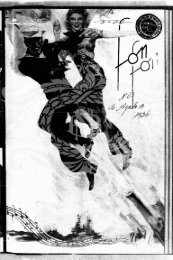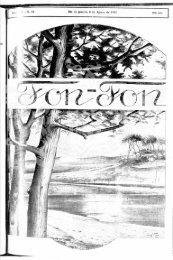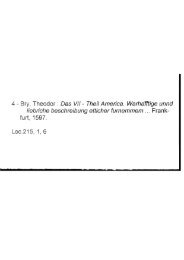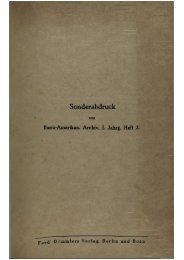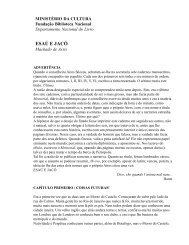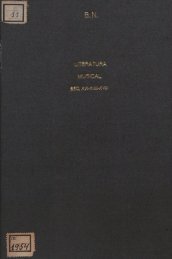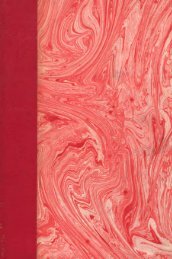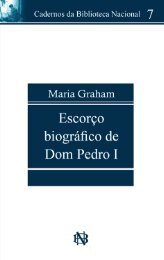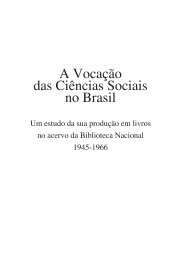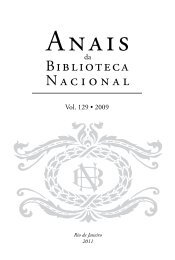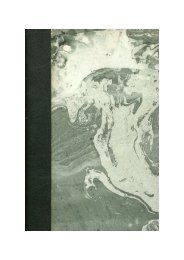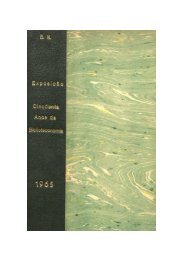- Page 1 and 2:
ANO XXXM-NÚMERO 5AL . *1980 RODRIG
- Page 3 and 4:
^io4 o3:o3 INVcMARÍ C -BN 0C.202.
- Page 5 and 6:
Jardim Botânico R. Jardim Botânic
- Page 7 and 8:
LAVOR, J. C. N. DE — Jardim Botâ
- Page 9 and 10:
Ovarii rudimentum minutum, tridenta
- Page 11 and 12:
10 Est. II c»r- Hf****
- Page 13 and 14:
O nome da espécie está relacionad
- Page 16 and 17: JACARANDA fflRSUTA VATTIMO n. sp. (
- Page 18 and 19: irregular, membranácea, com 5,5 cm
- Page 20 and 21: - ". - Est 1 - Jacaranda hirsuta Va
- Page 22 and 23: REVISÃO TAXONÔMICA DO GÊNERO VAT
- Page 24 and 25: QUADRO I Caracteres diferenciais do
- Page 26 and 27: Fig. 1 - Distribuição geográfica
- Page 28 and 29: 2t *J corte ^ a ^ or G, óvulo de
- Page 30 and 31: TRATAMENTO TAXONÔMICO Vataireopsis
- Page 32 and 33: 0,7-1 mm. lat. Pedicelli 3-5,5 mm.
- Page 34 and 35: DISTRIBUIÇÃO GEOGRÁFICA: Árvore
- Page 36 and 37: 1971b. Árvores e madeiras úteis d
- Page 38 and 39: Vataireopsis araroba (Aguiar) Ducke
- Page 40 and 41: Vitaireopsis surinamenris Lima (leg
- Page 42 and 43: CONTRIBUIÇÃO AO CONHECIMENTO DAS
- Page 44 and 45: mados, leg. Netto (Teb. 1876) R; Ca
- Page 46 and 47: ! \ \ Ett. I: 1 m •--.•< :*r- 3
- Page 48 and 49: o cr 10 « 5 1 O 8 7 6 6 4 3 FRUTO
- Page 50 and 51: 0 método adotado foi o mesmo para
- Page 52 and 53: 2. MODELOS ARBORESCENTES Compreende
- Page 54 and 55: za-se para dar cumprimento à miss
- Page 56 and 57: Fig. 1 - Indivíduos de vida subter
- Page 58 and 59: Fig. 3 - Indivíduos de vida aérea
- Page 60 and 61: NOTAS SOBRE ALGUNS ASPECTOS DA VEGE
- Page 62 and 63: A vegetação, em tempos idos const
- Page 64 and 65: 9 solo é constituído fundamentalm
- Page 68 and 69: Fig- 1 - Discocactus tricornis Monv
- Page 70 and 71: Fig. 3 Euphorbia angularis (n. sp.)
- Page 72 and 73: Fig. 5 - Mata seca em Itaobim, MG.,
- Page 74 and 75: 'JC* Jj Fig. 7 - Grande chapada de
- Page 76 and 77: Fig. 9 - Hábito de Melocactus dier
- Page 78 and 79: Fig. 11 - Cuspidaria cordata Mattos
- Page 80 and 81: Observamos uma adnação da parte b
- Page 82 and 83: Em seu aspecto representam duas fig
- Page 84 and 85: que as primeiras células secretora
- Page 88 and 89: 90 /•
- Page 92 and 93: 94 "5b ®
- Page 94 and 95: 0 © Qj^ 0 42
- Page 96 and 97: 98 54
- Page 98 and 99: Kvolvulus L. Ervas, arbustos, trepa
- Page 100 and 101: Evolvulus ericaefolius Schrank. (Fl
- Page 102 and 103: Área geográfica no Brasil: Soment
- Page 104 and 105: Obs.: Segundo Fl. Brás. de Martius
- Page 106 and 107: Ipomoea quamoclit L. (Sp. PI. 227.1
- Page 108 and 109: K - Folhas linear-lanceoladas: kl -
- Page 110 and 111: Obs.: Segundo Fl. Brás. de Mart. o
- Page 112 and 113: Foto 1 - Evolvulus ericaefolius. Fo
- Page 114 and 115: 116 Foto 4 - Evolvulu» nummularius
- Page 116 and 117:
118 jtUOiM BOTÂNICO 00 HlO Df i â
- Page 118 and 119:
120 Foto 8 - Jacquemontia velutina.
- Page 120 and 121:
122 Foto 10 - Merremia dissecta.
- Page 122 and 123:
ESTRUTURA DAS MADEIRAS BRASILEIRAS
- Page 124 and 125:
Obs.: Comum a presença de vasos co
- Page 126 and 127:
R. lindeniana: Amazonas, Rio Purús
- Page 128 and 129:
Pontuado rádio-vascular: pares sem
- Page 130 and 131:
Fibras: Cristais: romboidais comume
- Page 132 and 133:
Perfuração: simples e múltipla (
- Page 134 and 135:
Células envolventes: comumente pre
- Page 136 and 137:
3 VI - CONFRONTO DAS ESPÉCIES DE R
- Page 138 and 139:
Célula* aerfanda*: m criitui (ombo
- Page 140 and 141:
X - ABSTRACT Ktze., R. guianensis U
- Page 142 and 143:
Estampa 2 - Rinorea bahiensis (Mori
- Page 144 and 145:
Estampa 4 - Rinorea castaneaefolia
- Page 146 and 147:
Estampa 6 - Rinorea falcata (Mart.)
- Page 148 and 149:
Estampa 8 - Rinorea flavescens (Spr
- Page 150 and 151:
Estampa 10 - Rinoiea guianensis (Ei
- Page 152 and 153:
Estampa 12 - Rinorea lindeniana (Tu
- Page 154 and 155:
Estampa 14 - Rinorea racemosa (Mart
- Page 156 and 157:
Estampa 16 - Rinorea racemosa (Mart
- Page 158 and 159:
^ ^V\ Epiderme superior (vista fron
- Page 160 and 161:
EXPLICAÇÃO DAS LEGENDAS Estampa I
- Page 162 and 163:
166 Est. II - Miconia calvescens DC
- Page 164 and 165:
168 Est IV - Miconia prasina (Sw.)
- Page 166 and 167:
TIPOS DO HERBÁRIO DO JARDIM BOTÂN
- Page 168 and 169:
54 - Tibouchina dis&itiflora Wurdac
- Page 170 and 171:
Foto 1 - Tibouchina adamantinensis
- Page 172 and 173:
Foto 3 - Tibouchina apparicioi Brad
- Page 174 and 175:
Foto 5 - Tibouchina castellensis Br
- Page 176 and 177:
Foto 7 - Tibouchina Cogniauxu Glazi
- Page 178 and 179:
ti lhe»:», O Foto 9 - Tibouchina
- Page 180 and 181:
OO MO OI MM ^^^^^^^^•tVirtoii Fot
- Page 182 and 183:
Foto 13 - Tibouchina edmundoi Brade
- Page 184 and 185:
Foto 15 - Tibouchina Kunhardtii Gle
- Page 186 and 187:
Foto 17 - Tibouchina limoeirensis
- Page 188 and 189:
IDCIRCO, adv. - Por isso. Et genus
- Page 190 and 191:
IMBRICATUS, a, um, adj. - Imbricado
- Page 192 and 193:
primerentur (FB): enquanto estas fo
- Page 194 and 195:
fructibus vescuntur (FB): os nativo
- Page 196 and 197:
INDISTINCTUS, a, um, adj. — Indis
- Page 198 and 199:
INFIMUS, a, um, adi. — Superl. de
- Page 200 and 201:
INNOVATIO, onis, subs. f. 3 — Bro
- Page 202 and 203:
INSPECTUS, a, um, adj. - Examinado,
- Page 204 and 205:
penetra pouco no interior. Cf. vita
- Page 206 and 207:
trorsum pertinere: que uma floresta
- Page 208 and 209:
IRREGULARITER, adv. — Iiregularme
- Page 210 and 211:
JANEIRENSIS, e, adj. - O mesmo que
- Page 212 and 213:
gem apenas. Disso resulta que uma f
- Page 214 and 215:
LAPIDOSUS, a, um, adj. — Pedregos
- Page 216 and 217:
LECTOR, oris, subs. m. 3 — Leitor
- Page 218 and 219:
LICET, conj. — Ainda que, embora.
- Page 220 and 221:
LINUM, i, subs. n. 2 - Linho (plant
- Page 222 and 223:
medicamentam, natalis, occurro, opa
- Page 224 and 225:
LUPINACEUS, a, om, adj. — De trem
- Page 226 and 227:
MAGNUS, a, um, adj. — Grande, ext
- Page 228 and 229:
MARGINATUS, a, um, adj. — Margina
- Page 230 and 231:
MEDIALIS, e, adj. — Mediano. Sori
- Page 232 and 233:
MEMÓRIA, ae, subs. f. 1 — Memór
- Page 234 and 235:
(M): apresenta flores pequenas, com
- Page 236 and 237:
MONOSPERMUS, a, um, adj. - Linné:
- Page 238 and 239:
terminará o gênero. Ex his arbori
- Page 240 and 241:
"Musaeum Regalis Societatis" (o Mus
- Page 242 and 243:
SUMMARY This paper is connected wit
- Page 244 and 245:
BIcchnum itatiaiense Brade (1935):
- Page 246 and 247:
O exemplar RB 66959, é HOLOTYPUS,
- Page 248 and 249:
BRYOPHYTA (MUSCI) DO HERBÁRIO DO J
- Page 250 and 251:
15 - Vesicularia glaucopinnata CM.
- Page 252 and 253:
|>rio, sem frutificações, M. Band
- Page 254 and 255:
54 - Neckeropsis ralstiana (CM.) Br
- Page 256 and 257:
Teresópolis, em árvore viva na ma
- Page 258 and 259:
D. Sucre 2443 e P. Braga 285, març
- Page 260 and 261:
HASSKARL (1852: 187) aceita o gêne
- Page 262 and 263:
272 CHAVE Flores pediceladas; pedic
- Page 264 and 265:
n - Lâmina foliar pubescente na fa
- Page 266 and 267:
BAHIA - Espigão Mestre, tree ca. 5
- Page 268 and 269:
3,0-6,5 cm de largura, elfptica, ba
- Page 270 and 271:
Paraná do Maria, subsarmentosa, fl
- Page 272 and 273:
GUIANA INGLESA - Leg. Schomburgk 33
- Page 274 and 275:
7.2 Bredemeyera myrtifolia f. huber
- Page 276 and 277:
BAHIA - Leg. Blanchet 3946, C; Port
- Page 278 and 279:
Firme, i 23 km da Univ. Viçosa e a
- Page 280 and 281:
Guillemin 786 (1839), F; Nova Fribu
- Page 282 and 283:
1903. Bredemeyera floribunda f. sub
- Page 284 and 285:
294
- Page 286 and 287:
91 \ [ (v Sá •,-> •» í r» r
- Page 288 and 289:
298 Estampa 5 - Fotótipo de Bredem
- Page 290 and 291:
300 Estampa 7 - Síntipo de Bredeme
- Page 292 and 293:
Estampa 9 - Bredemeyen altíssima (
- Page 294 and 295:
304 • Estampa 11 - Holótipo de B
- Page 296 and 297:
Estampa 13 - Síntipo de Bredemeyer
- Page 298 and 299:
Estampa 15 - Síntipo de Bredemeyer
- Page 300 and 301:
310 Estampa 17 - Tipo de Bredemeyer
- Page 302 and 303:
312 EiUmpi 19 - Holótípo de Brede
- Page 304 and 305:
314 Estampa 21 - Bredemeyera laurif
- Page 306 and 307:
316 Estampa 23 - Síntipo de Bredem
- Page 308 and 309:
318 '0?// I,. I Estampa 25 - Sínti
- Page 310 and 311:
Estampa 27 - Bredemeyera kunthiana
- Page 312 and 313:
CONTRIBUIÇÃO AO CONHECIMENTO DA E
- Page 314 and 315:
neração da vegetação devem ser
- Page 316 and 317:
CONTRIBUIÇÃO AO ESTUDO FARMACOGN
- Page 318 and 319:
e do micrótomo tipo Ranvier, coloc
- Page 320 and 321:
diâmetro. Conprovamos a presença
- Page 322 and 323:
Dimetilacetamida - clorofórmio (1:
- Page 324 and 325:
17 - FONT QUER, P. Dicionário de B
- Page 326 and 327:
Fig. 2 - Epiderme inferior (4 OOX).
- Page 328 and 329:
Fig. 4 - Corte transversal do limbo
- Page 330 and 331:
Fig. 6 - Corte transversal da nervu
- Page 332 and 333:
Fig. 8 - Corte transversal do pecio
- Page 334 and 335:
Fig. 10 - Corte transversal do caul
- Page 336 and 337:
Fig.12 - Corte transversal da raiz
- Page 338 and 339:
Fig. 14 - Cristais sob forma de agu
- Page 340 and 341:
BRASIL: MINAS GERAIS - Caldas, no a
- Page 342 and 343:
BRASIL: MINAS GERAIS - Sem de Ibiap
- Page 344 and 345:
14- Ocotea costulata (Nees) Mez Mez
- Page 346 and 347:
junho 1918 (S-Herb. III 9287); Prov
- Page 348 and 349:
Rio Novo, Araújo s.n., ex Herb. Sc
- Page 350 and 351:
MATO GROSSO - Margem do Rio Juruena
- Page 352 and 353:
cional do Itatiaia, HOOmsm, "canela
- Page 354 and 355:
isolada nos campos, A. P. Duarte 34
- Page 356 and 357:
JARDIM BOTÂNICO DO RIO DE JANEIRO.
- Page 358 and 359:
1 - Prédio da Administração Cent
- Page 360 and 361:
Seu projeto entre outros, se deveu
- Page 362 and 363:
A Professora Celita Vaccani, após
- Page 364 and 365:
do Bastos de Menezes, ex-Diretor do
- Page 366 and 367:
4 - Da estufa n.° 3 A estufa n.°
- Page 368 and 369:
S. A. — 4a. edição. NfEMEYER DE
- Page 370 and 371:
Moradia de ex-diretores, conhecida
- Page 372 and 373:
Imperial Ordem da Rosa Casa dos Pil
- Page 374 and 375:
Prédio do setor de botânica siste
- Page 376 and 377:
Ninfa Éco, primeira estátua fundi
- Page 378 and 379:
8 Diana Ceres
- Page 380 and 381:
s Xochiquétzal e Xochipüli. Xochi
- Page 382 and 383:
s A mesma escultura no interior do
- Page 384 and 385:
D. João VI O escultor Rodolfo Bema
- Page 386 and 387:
Von Martius r? • M ' *VL. ns^Í£
- Page 388 and 389:
Fonte do cactário Mós 403
- Page 390 and 391:
Bebedouro de pássaros Escudo ental
- Page 392 and 393:
NOTICIÁRIO FLORA OF BARRO COLORADO
- Page 394 and 395:
Diagramação, Composição, Arte-f
- Page 396 and 397:
ANEXO DA REVISTA "RODRIGUÊSIA" ANO
- Page 398 and 399:
BIBLIOGRAFIA BOTÂNICA. IV. ANATOMI
- Page 400 and 401:
JAMES, L E et KYHOS, D. W. 1961. Th
- Page 402 and 403:
JOHNSTON, G. W. 1961. Microsporogen
- Page 404 and 405:
KARLING, J. S 1930. The laticiferou
- Page 406 and 407:
KERLING, L C P. 1933. The anatomy o
- Page 408 and 409:
KN0X-DAV1ES, P. & et DlCKSON, J. G.
- Page 410 and 411:
KUGRENS, P. et WEST, J. A. 1972. Sy
- Page 412 and 413:
LAMOTTE, C. E et JACOBS, W. P. 1962
- Page 414 and 415:
LAWREY, J. D. 1977. X-ray emission
- Page 416 and 417:
et CURTIS, J. D. 1977. Preliminary
- Page 418 and 419:
LINSLEY, E G. et THORP, R. W. 1973.
- Page 420 and 421:
LOUREIRO, A A. 1971. Contribuição



